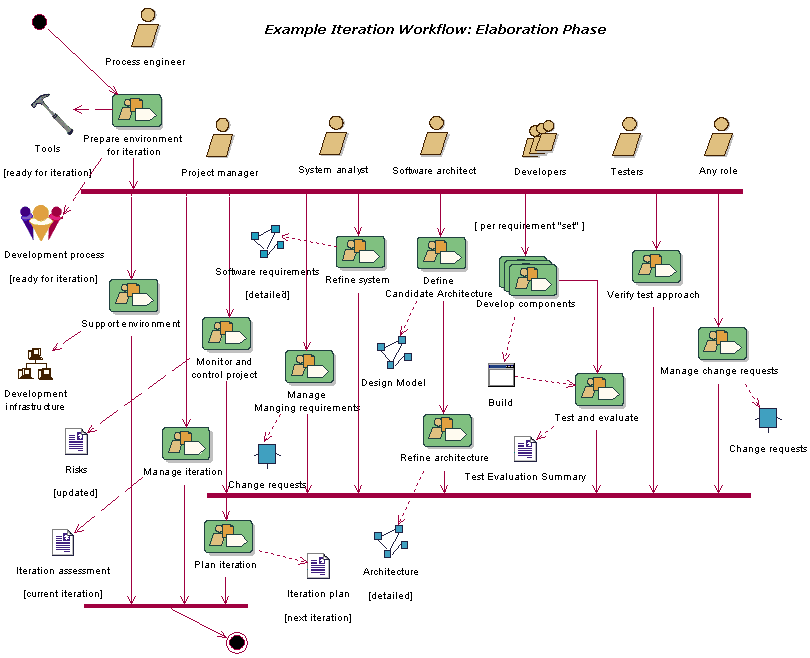Phase: Elaboration
|
The goal of the elaboration phase is to baseline the architecture of the system to provide a stable basis for the bulk of the design and implementation effort in the construction phase. The architecture evolves out of a consideration of the most significant requirements (those that have a great impact on the architecture of the system) and an assessment of risk. The stability of the architecture is evaluated through one or more architectural prototypes. | |
|
Workflow details typically performed in an iteration in Elaboration for medium sized projects. |
Objectives
![]()
The primary objectives of the Elaboration phase include:
- To ensure that the architecture, requirements and plans are stable enough, and the risks sufficiently mitigated to be able to predictably determine the cost and schedule for the completion of the development. For most projects, passing this milestone also corresponds to the transition from a light-and-fast, low-risk operation to a high cost, high risk operation with substantial organizational inertia.
- To address all architecturally significant risks of the project
- To establish a baselined architecture derived from addressing the architecturally significant scenarios, which typically expose the top technical risks of the project.
- To produce an evolutionary prototype
of production-quality components, as well as possibly one or more exploratory,
throw-away prototypes to mitigate specific risks such as:
- design/requirements trade-offs
- component reuse
- product feasibility or demonstrations to investors, customers, and end-users.
- To demonstrate that the baselined architecture will support the requirements of the system at a reasonable cost and in a reasonable time.
- To establish a supporting environment.
In order to achieve these primary objectives, it is equally important to set up the supporting environment for the project. This includes creating a development case, preparing templates, guidelines, and setting up tools.
Essential Activities
![]()
The essential activities of the Elaboration phase include:
- Defining, validating and baselining the architecture as rapidly as practical.
- Refining the Vision, based on new information obtained during the phase, establishing a solid understanding of the most critical use cases that drive the architectural and planning decisions.
- Creating and baselining detailed iteration plans for the construction phase.
- Refining the development case and putting in place the development environment, including the process, tools and automation support required to support the construction team.
- Refining the architecture and selecting components. Potential components are evaluated and the make/buy/reuse decisions sufficiently understood to determine the construction phase cost and schedule with confidence. The selected architectural components are integrated and assessed against the primary scenarios. Lessons learned from these activities may well result in a redesign of the architecture, taking into consideration alternative designs or reconsideration of the requirements.
Milestone
![]()
The Lifecycle Architecture milestone establishes a managed baseline for the architecture of the system and enables the project team to scale during the Construction phase. See Milestone: Lifecycle Architecture for details.
Tailoring Decisions
![]()
The example iteration workflow shown at the top
of this page represents a typical Elaboration iteration in
medium sized projects. The
 Sample Iteration Plan: Elaboration
Phase
Sample Iteration Plan: Elaboration
Phase

